Nursing Research Midterm Assignment, Healthcare, October 22, 2018
VerifiedAdded on 2023/06/03
|15
|4672
|107
Homework Assignment
AI Summary
This document contains the solutions to a midterm assignment in nursing research. The assignment covers a wide range of topics, including the role of research in nursing practice, different research methodologies (qualitative, quantitative, and mixed methods), and key concepts such as data saturation, meta-synthesis, and ethnographic research. The questions assess understanding of research designs, data analysis techniques (thematic analysis, triangulation), and criteria for evaluating research quality (trustworthiness, confirmability). The assignment also explores sampling methods, action research, and the application of research findings in evidence-based practice. Overall, the assignment aims to evaluate the student's comprehension of core research principles and their ability to apply these principles to nursing practice.
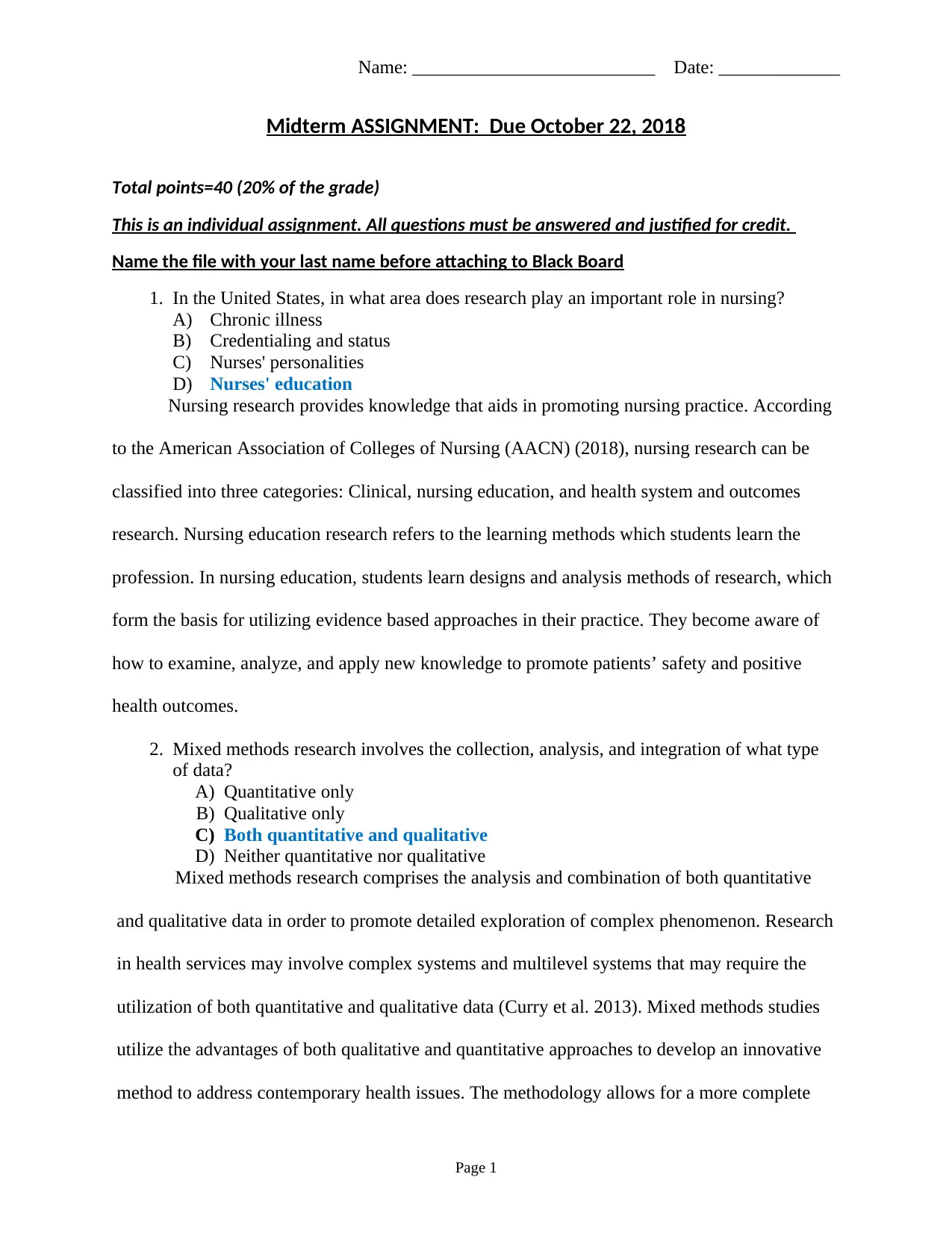
Name: __________________________ Date: _____________
Midterm ASSIGNMENT: Due October 22, 2018
Total points=40 (20% of the grade)
This is an individual assignment. All questions must be answered and justified for credit.
Name the file with your last name before attaching to Black Board
1. In the United States, in what area does research play an important role in nursing?
A) Chronic illness
B) Credentialing and status
C) Nurses' personalities
D) Nurses' education
Nursing research provides knowledge that aids in promoting nursing practice. According
to the American Association of Colleges of Nursing (AACN) (2018), nursing research can be
classified into three categories: Clinical, nursing education, and health system and outcomes
research. Nursing education research refers to the learning methods which students learn the
profession. In nursing education, students learn designs and analysis methods of research, which
form the basis for utilizing evidence based approaches in their practice. They become aware of
how to examine, analyze, and apply new knowledge to promote patients’ safety and positive
health outcomes.
2. Mixed methods research involves the collection, analysis, and integration of what type
of data?
A) Quantitative only
B) Qualitative only
C) Both quantitative and qualitative
D) Neither quantitative nor qualitative
Mixed methods research comprises the analysis and combination of both quantitative
and qualitative data in order to promote detailed exploration of complex phenomenon. Research
in health services may involve complex systems and multilevel systems that may require the
utilization of both quantitative and qualitative data (Curry et al. 2013). Mixed methods studies
utilize the advantages of both qualitative and quantitative approaches to develop an innovative
method to address contemporary health issues. The methodology allows for a more complete
Page 1
Midterm ASSIGNMENT: Due October 22, 2018
Total points=40 (20% of the grade)
This is an individual assignment. All questions must be answered and justified for credit.
Name the file with your last name before attaching to Black Board
1. In the United States, in what area does research play an important role in nursing?
A) Chronic illness
B) Credentialing and status
C) Nurses' personalities
D) Nurses' education
Nursing research provides knowledge that aids in promoting nursing practice. According
to the American Association of Colleges of Nursing (AACN) (2018), nursing research can be
classified into three categories: Clinical, nursing education, and health system and outcomes
research. Nursing education research refers to the learning methods which students learn the
profession. In nursing education, students learn designs and analysis methods of research, which
form the basis for utilizing evidence based approaches in their practice. They become aware of
how to examine, analyze, and apply new knowledge to promote patients’ safety and positive
health outcomes.
2. Mixed methods research involves the collection, analysis, and integration of what type
of data?
A) Quantitative only
B) Qualitative only
C) Both quantitative and qualitative
D) Neither quantitative nor qualitative
Mixed methods research comprises the analysis and combination of both quantitative
and qualitative data in order to promote detailed exploration of complex phenomenon. Research
in health services may involve complex systems and multilevel systems that may require the
utilization of both quantitative and qualitative data (Curry et al. 2013). Mixed methods studies
utilize the advantages of both qualitative and quantitative approaches to develop an innovative
method to address contemporary health issues. The methodology allows for a more complete
Page 1
Paraphrase This Document
Need a fresh take? Get an instant paraphrase of this document with our AI Paraphraser
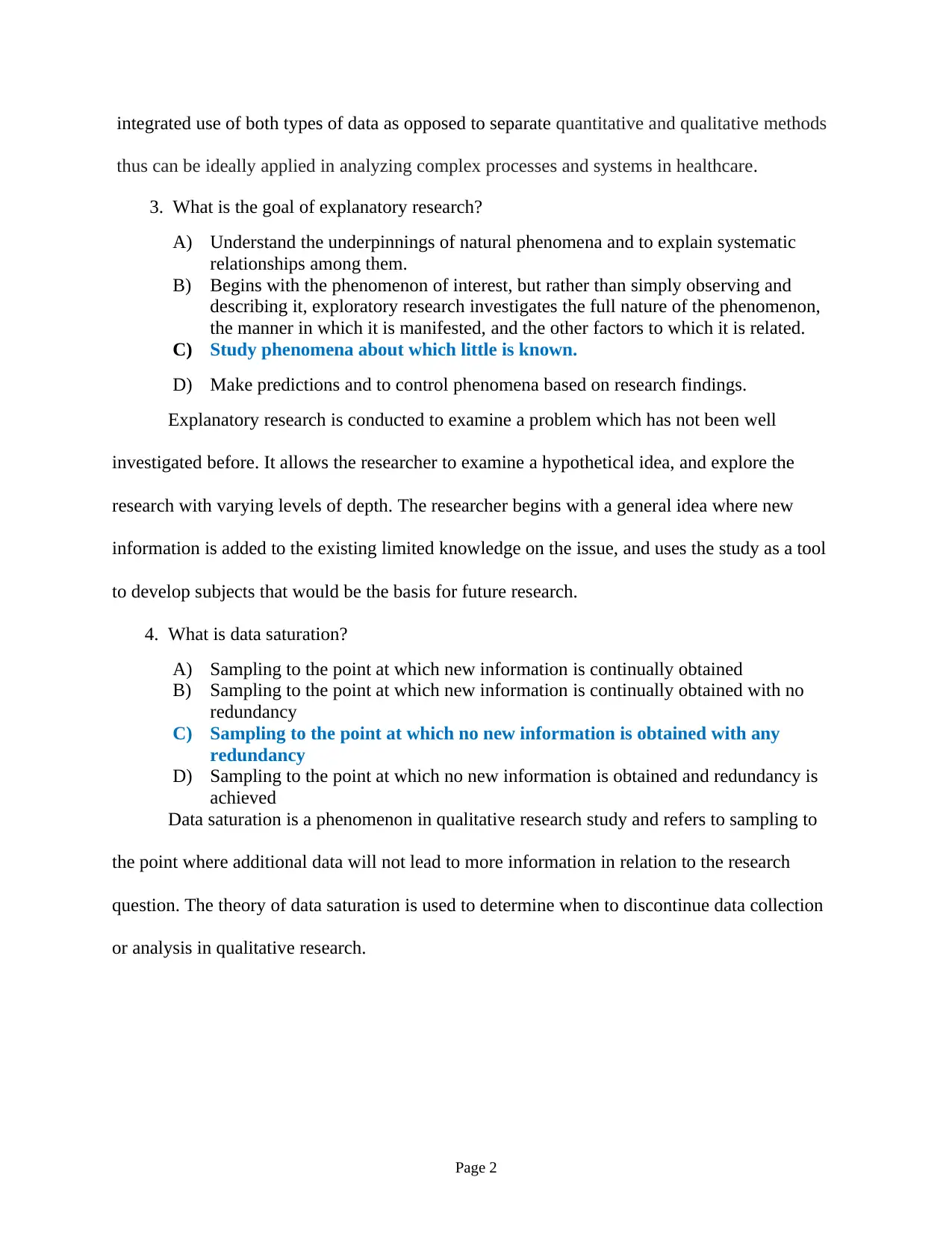
integrated use of both types of data as opposed to separate quantitative and qualitative methods
thus can be ideally applied in analyzing complex processes and systems in healthcare.
3. What is the goal of explanatory research?
A) Understand the underpinnings of natural phenomena and to explain systematic
relationships among them.
B) Begins with the phenomenon of interest, but rather than simply observing and
describing it, exploratory research investigates the full nature of the phenomenon,
the manner in which it is manifested, and the other factors to which it is related.
C) Study phenomena about which little is known.
D) Make predictions and to control phenomena based on research findings.
Explanatory research is conducted to examine a problem which has not been well
investigated before. It allows the researcher to examine a hypothetical idea, and explore the
research with varying levels of depth. The researcher begins with a general idea where new
information is added to the existing limited knowledge on the issue, and uses the study as a tool
to develop subjects that would be the basis for future research.
4. What is data saturation?
A) Sampling to the point at which new information is continually obtained
B) Sampling to the point at which new information is continually obtained with no
redundancy
C) Sampling to the point at which no new information is obtained with any
redundancy
D) Sampling to the point at which no new information is obtained and redundancy is
achieved
Data saturation is a phenomenon in qualitative research study and refers to sampling to
the point where additional data will not lead to more information in relation to the research
question. The theory of data saturation is used to determine when to discontinue data collection
or analysis in qualitative research.
Page 2
thus can be ideally applied in analyzing complex processes and systems in healthcare.
3. What is the goal of explanatory research?
A) Understand the underpinnings of natural phenomena and to explain systematic
relationships among them.
B) Begins with the phenomenon of interest, but rather than simply observing and
describing it, exploratory research investigates the full nature of the phenomenon,
the manner in which it is manifested, and the other factors to which it is related.
C) Study phenomena about which little is known.
D) Make predictions and to control phenomena based on research findings.
Explanatory research is conducted to examine a problem which has not been well
investigated before. It allows the researcher to examine a hypothetical idea, and explore the
research with varying levels of depth. The researcher begins with a general idea where new
information is added to the existing limited knowledge on the issue, and uses the study as a tool
to develop subjects that would be the basis for future research.
4. What is data saturation?
A) Sampling to the point at which new information is continually obtained
B) Sampling to the point at which new information is continually obtained with no
redundancy
C) Sampling to the point at which no new information is obtained with any
redundancy
D) Sampling to the point at which no new information is obtained and redundancy is
achieved
Data saturation is a phenomenon in qualitative research study and refers to sampling to
the point where additional data will not lead to more information in relation to the research
question. The theory of data saturation is used to determine when to discontinue data collection
or analysis in qualitative research.
Page 2
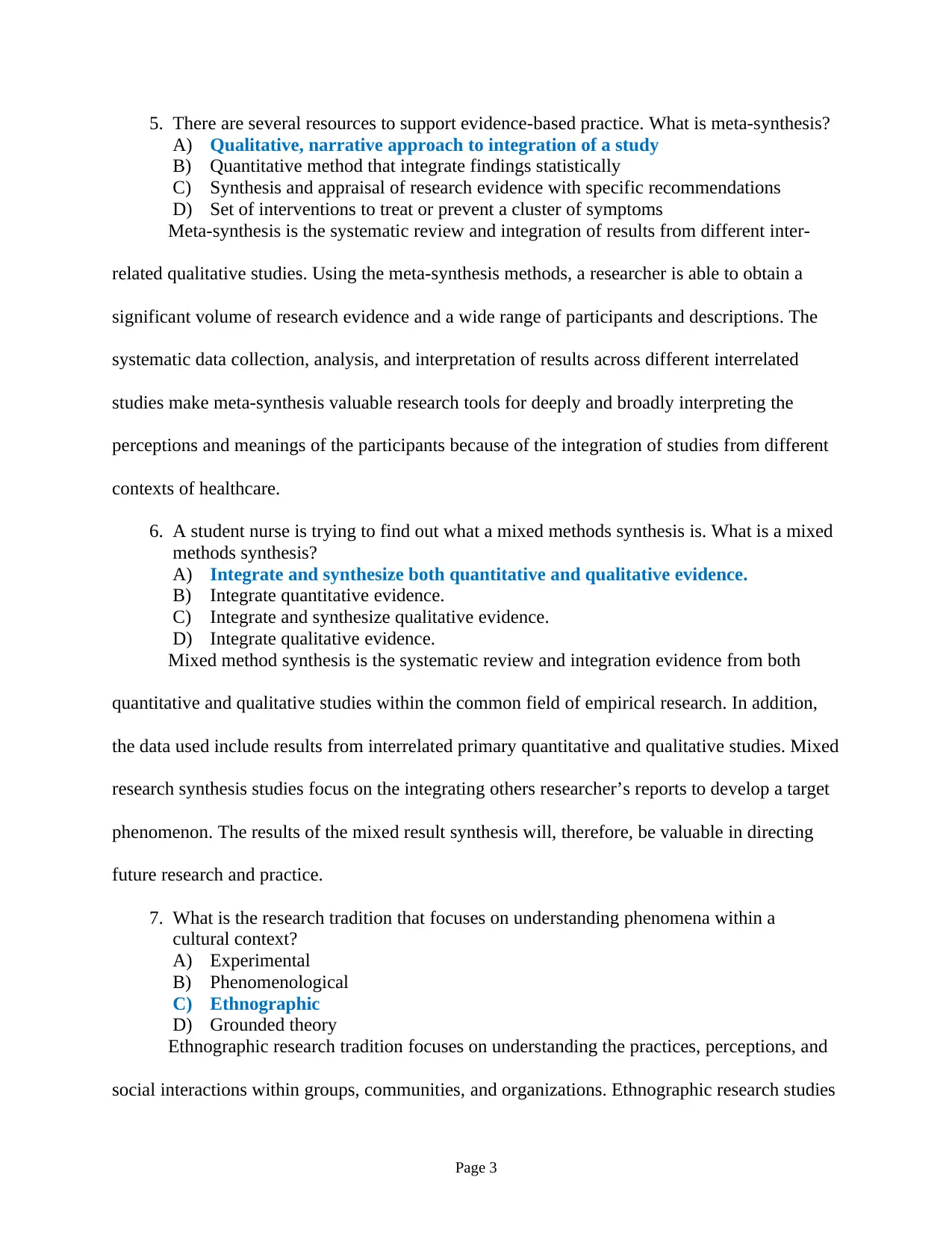
5. There are several resources to support evidence-based practice. What is meta-synthesis?
A) Qualitative, narrative approach to integration of a study
B) Quantitative method that integrate findings statistically
C) Synthesis and appraisal of research evidence with specific recommendations
D) Set of interventions to treat or prevent a cluster of symptoms
Meta-synthesis is the systematic review and integration of results from different inter-
related qualitative studies. Using the meta-synthesis methods, a researcher is able to obtain a
significant volume of research evidence and a wide range of participants and descriptions. The
systematic data collection, analysis, and interpretation of results across different interrelated
studies make meta-synthesis valuable research tools for deeply and broadly interpreting the
perceptions and meanings of the participants because of the integration of studies from different
contexts of healthcare.
6. A student nurse is trying to find out what a mixed methods synthesis is. What is a mixed
methods synthesis?
A) Integrate and synthesize both quantitative and qualitative evidence.
B) Integrate quantitative evidence.
C) Integrate and synthesize qualitative evidence.
D) Integrate qualitative evidence.
Mixed method synthesis is the systematic review and integration evidence from both
quantitative and qualitative studies within the common field of empirical research. In addition,
the data used include results from interrelated primary quantitative and qualitative studies. Mixed
research synthesis studies focus on the integrating others researcher’s reports to develop a target
phenomenon. The results of the mixed result synthesis will, therefore, be valuable in directing
future research and practice.
7. What is the research tradition that focuses on understanding phenomena within a
cultural context?
A) Experimental
B) Phenomenological
C) Ethnographic
D) Grounded theory
Ethnographic research tradition focuses on understanding the practices, perceptions, and
social interactions within groups, communities, and organizations. Ethnographic research studies
Page 3
A) Qualitative, narrative approach to integration of a study
B) Quantitative method that integrate findings statistically
C) Synthesis and appraisal of research evidence with specific recommendations
D) Set of interventions to treat or prevent a cluster of symptoms
Meta-synthesis is the systematic review and integration of results from different inter-
related qualitative studies. Using the meta-synthesis methods, a researcher is able to obtain a
significant volume of research evidence and a wide range of participants and descriptions. The
systematic data collection, analysis, and interpretation of results across different interrelated
studies make meta-synthesis valuable research tools for deeply and broadly interpreting the
perceptions and meanings of the participants because of the integration of studies from different
contexts of healthcare.
6. A student nurse is trying to find out what a mixed methods synthesis is. What is a mixed
methods synthesis?
A) Integrate and synthesize both quantitative and qualitative evidence.
B) Integrate quantitative evidence.
C) Integrate and synthesize qualitative evidence.
D) Integrate qualitative evidence.
Mixed method synthesis is the systematic review and integration evidence from both
quantitative and qualitative studies within the common field of empirical research. In addition,
the data used include results from interrelated primary quantitative and qualitative studies. Mixed
research synthesis studies focus on the integrating others researcher’s reports to develop a target
phenomenon. The results of the mixed result synthesis will, therefore, be valuable in directing
future research and practice.
7. What is the research tradition that focuses on understanding phenomena within a
cultural context?
A) Experimental
B) Phenomenological
C) Ethnographic
D) Grounded theory
Ethnographic research tradition focuses on understanding the practices, perceptions, and
social interactions within groups, communities, and organizations. Ethnographic research studies
Page 3
⊘ This is a preview!⊘
Do you want full access?
Subscribe today to unlock all pages.

Trusted by 1+ million students worldwide
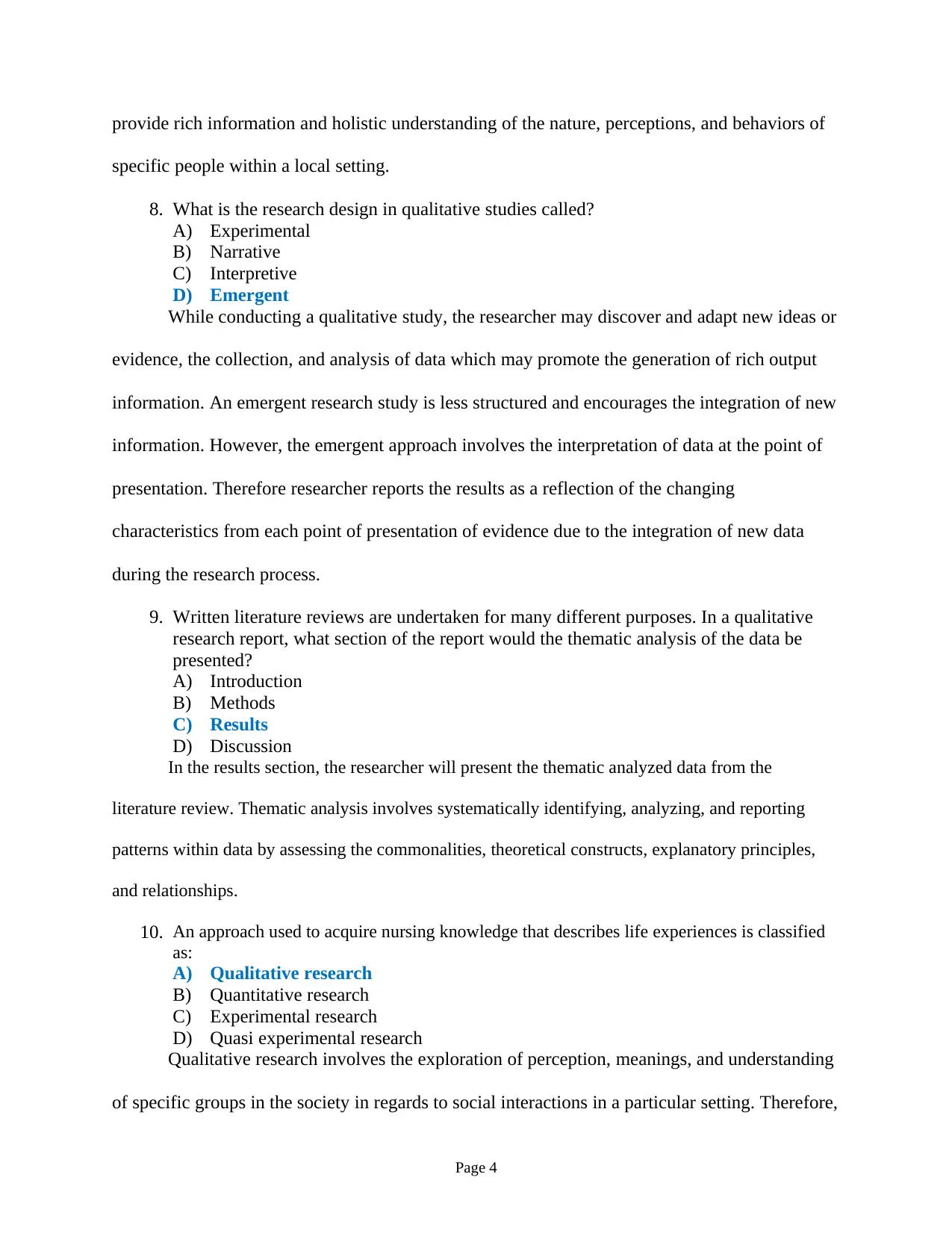
provide rich information and holistic understanding of the nature, perceptions, and behaviors of
specific people within a local setting.
8. What is the research design in qualitative studies called?
A) Experimental
B) Narrative
C) Interpretive
D) Emergent
While conducting a qualitative study, the researcher may discover and adapt new ideas or
evidence, the collection, and analysis of data which may promote the generation of rich output
information. An emergent research study is less structured and encourages the integration of new
information. However, the emergent approach involves the interpretation of data at the point of
presentation. Therefore researcher reports the results as a reflection of the changing
characteristics from each point of presentation of evidence due to the integration of new data
during the research process.
9. Written literature reviews are undertaken for many different purposes. In a qualitative
research report, what section of the report would the thematic analysis of the data be
presented?
A) Introduction
B) Methods
C) Results
D) Discussion
In the results section, the researcher will present the thematic analyzed data from the
literature review. Thematic analysis involves systematically identifying, analyzing, and reporting
patterns within data by assessing the commonalities, theoretical constructs, explanatory principles,
and relationships.
10. An approach used to acquire nursing knowledge that describes life experiences is classified
as:
A) Qualitative research
B) Quantitative research
C) Experimental research
D) Quasi experimental research
Qualitative research involves the exploration of perception, meanings, and understanding
of specific groups in the society in regards to social interactions in a particular setting. Therefore,
Page 4
specific people within a local setting.
8. What is the research design in qualitative studies called?
A) Experimental
B) Narrative
C) Interpretive
D) Emergent
While conducting a qualitative study, the researcher may discover and adapt new ideas or
evidence, the collection, and analysis of data which may promote the generation of rich output
information. An emergent research study is less structured and encourages the integration of new
information. However, the emergent approach involves the interpretation of data at the point of
presentation. Therefore researcher reports the results as a reflection of the changing
characteristics from each point of presentation of evidence due to the integration of new data
during the research process.
9. Written literature reviews are undertaken for many different purposes. In a qualitative
research report, what section of the report would the thematic analysis of the data be
presented?
A) Introduction
B) Methods
C) Results
D) Discussion
In the results section, the researcher will present the thematic analyzed data from the
literature review. Thematic analysis involves systematically identifying, analyzing, and reporting
patterns within data by assessing the commonalities, theoretical constructs, explanatory principles,
and relationships.
10. An approach used to acquire nursing knowledge that describes life experiences is classified
as:
A) Qualitative research
B) Quantitative research
C) Experimental research
D) Quasi experimental research
Qualitative research involves the exploration of perception, meanings, and understanding
of specific groups in the society in regards to social interactions in a particular setting. Therefore,
Page 4
Paraphrase This Document
Need a fresh take? Get an instant paraphrase of this document with our AI Paraphraser
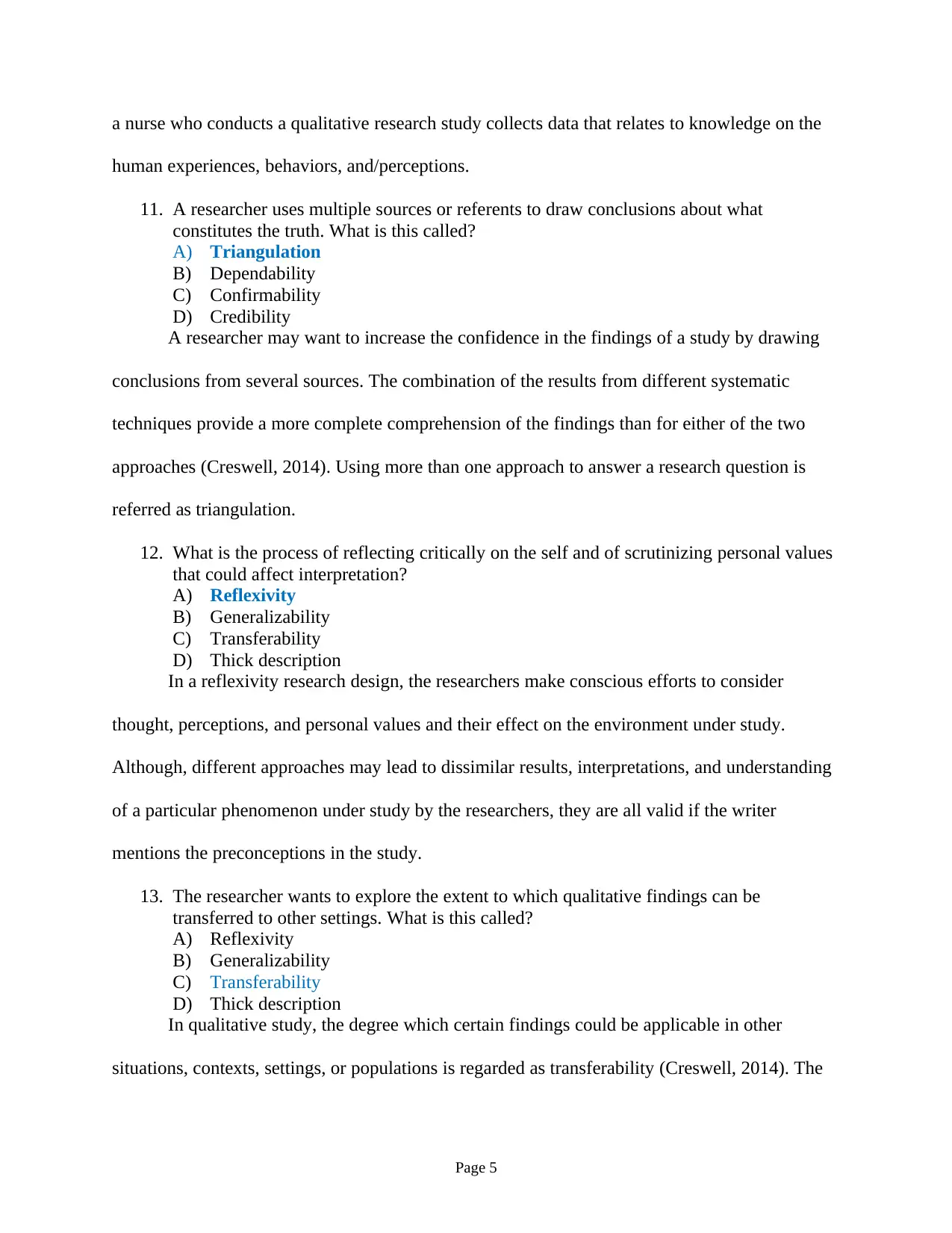
a nurse who conducts a qualitative research study collects data that relates to knowledge on the
human experiences, behaviors, and/perceptions.
11. A researcher uses multiple sources or referents to draw conclusions about what
constitutes the truth. What is this called?
A) Triangulation
B) Dependability
C) Confirmability
D) Credibility
A researcher may want to increase the confidence in the findings of a study by drawing
conclusions from several sources. The combination of the results from different systematic
techniques provide a more complete comprehension of the findings than for either of the two
approaches (Creswell, 2014). Using more than one approach to answer a research question is
referred as triangulation.
12. What is the process of reflecting critically on the self and of scrutinizing personal values
that could affect interpretation?
A) Reflexivity
B) Generalizability
C) Transferability
D) Thick description
In a reflexivity research design, the researchers make conscious efforts to consider
thought, perceptions, and personal values and their effect on the environment under study.
Although, different approaches may lead to dissimilar results, interpretations, and understanding
of a particular phenomenon under study by the researchers, they are all valid if the writer
mentions the preconceptions in the study.
13. The researcher wants to explore the extent to which qualitative findings can be
transferred to other settings. What is this called?
A) Reflexivity
B) Generalizability
C) Transferability
D) Thick description
In qualitative study, the degree which certain findings could be applicable in other
situations, contexts, settings, or populations is regarded as transferability (Creswell, 2014). The
Page 5
human experiences, behaviors, and/perceptions.
11. A researcher uses multiple sources or referents to draw conclusions about what
constitutes the truth. What is this called?
A) Triangulation
B) Dependability
C) Confirmability
D) Credibility
A researcher may want to increase the confidence in the findings of a study by drawing
conclusions from several sources. The combination of the results from different systematic
techniques provide a more complete comprehension of the findings than for either of the two
approaches (Creswell, 2014). Using more than one approach to answer a research question is
referred as triangulation.
12. What is the process of reflecting critically on the self and of scrutinizing personal values
that could affect interpretation?
A) Reflexivity
B) Generalizability
C) Transferability
D) Thick description
In a reflexivity research design, the researchers make conscious efforts to consider
thought, perceptions, and personal values and their effect on the environment under study.
Although, different approaches may lead to dissimilar results, interpretations, and understanding
of a particular phenomenon under study by the researchers, they are all valid if the writer
mentions the preconceptions in the study.
13. The researcher wants to explore the extent to which qualitative findings can be
transferred to other settings. What is this called?
A) Reflexivity
B) Generalizability
C) Transferability
D) Thick description
In qualitative study, the degree which certain findings could be applicable in other
situations, contexts, settings, or populations is regarded as transferability (Creswell, 2014). The
Page 5
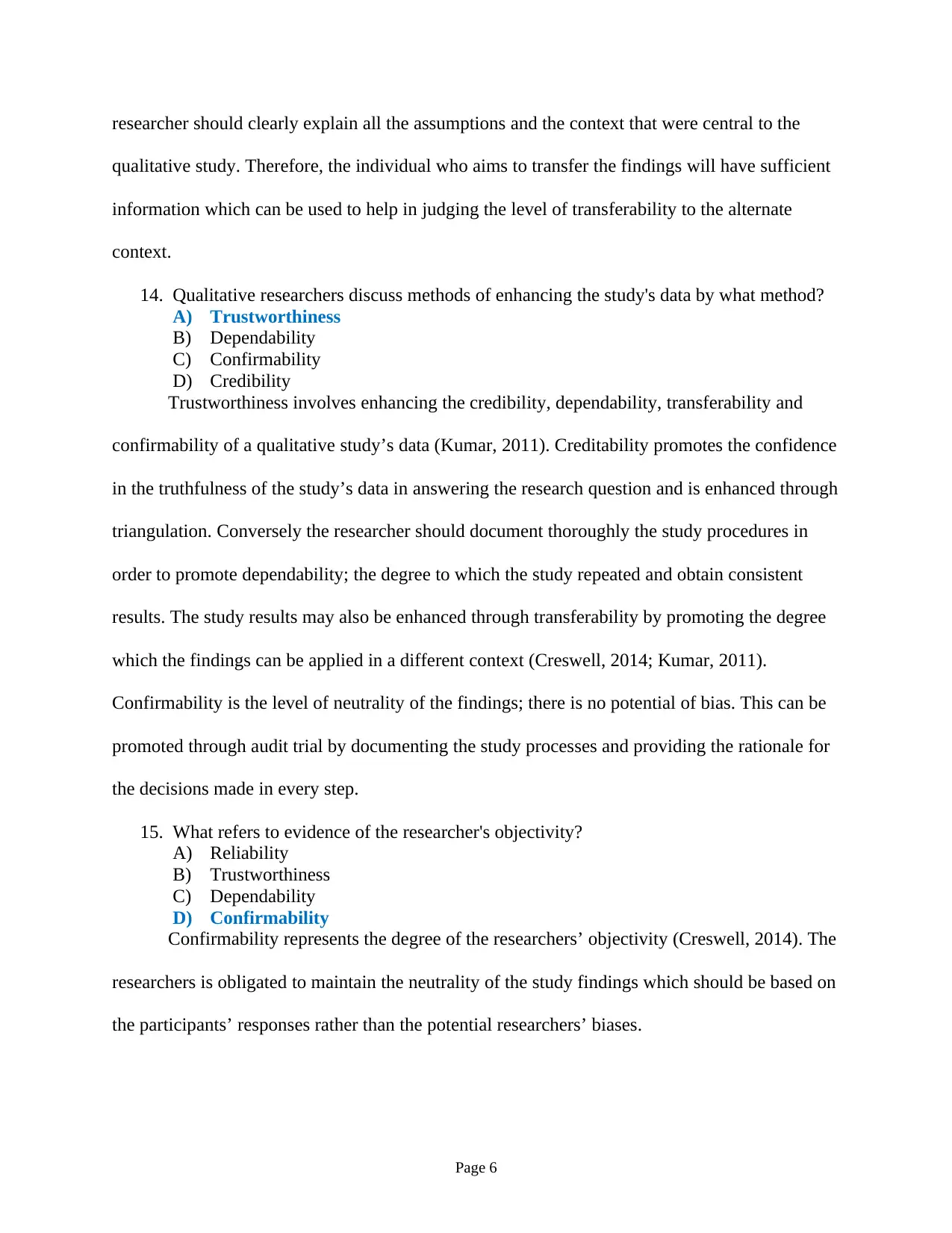
researcher should clearly explain all the assumptions and the context that were central to the
qualitative study. Therefore, the individual who aims to transfer the findings will have sufficient
information which can be used to help in judging the level of transferability to the alternate
context.
14. Qualitative researchers discuss methods of enhancing the study's data by what method?
A) Trustworthiness
B) Dependability
C) Confirmability
D) Credibility
Trustworthiness involves enhancing the credibility, dependability, transferability and
confirmability of a qualitative study’s data (Kumar, 2011). Creditability promotes the confidence
in the truthfulness of the study’s data in answering the research question and is enhanced through
triangulation. Conversely the researcher should document thoroughly the study procedures in
order to promote dependability; the degree to which the study repeated and obtain consistent
results. The study results may also be enhanced through transferability by promoting the degree
which the findings can be applied in a different context (Creswell, 2014; Kumar, 2011).
Confirmability is the level of neutrality of the findings; there is no potential of bias. This can be
promoted through audit trial by documenting the study processes and providing the rationale for
the decisions made in every step.
15. What refers to evidence of the researcher's objectivity?
A) Reliability
B) Trustworthiness
C) Dependability
D) Confirmability
Confirmability represents the degree of the researchers’ objectivity (Creswell, 2014). The
researchers is obligated to maintain the neutrality of the study findings which should be based on
the participants’ responses rather than the potential researchers’ biases.
Page 6
qualitative study. Therefore, the individual who aims to transfer the findings will have sufficient
information which can be used to help in judging the level of transferability to the alternate
context.
14. Qualitative researchers discuss methods of enhancing the study's data by what method?
A) Trustworthiness
B) Dependability
C) Confirmability
D) Credibility
Trustworthiness involves enhancing the credibility, dependability, transferability and
confirmability of a qualitative study’s data (Kumar, 2011). Creditability promotes the confidence
in the truthfulness of the study’s data in answering the research question and is enhanced through
triangulation. Conversely the researcher should document thoroughly the study procedures in
order to promote dependability; the degree to which the study repeated and obtain consistent
results. The study results may also be enhanced through transferability by promoting the degree
which the findings can be applied in a different context (Creswell, 2014; Kumar, 2011).
Confirmability is the level of neutrality of the findings; there is no potential of bias. This can be
promoted through audit trial by documenting the study processes and providing the rationale for
the decisions made in every step.
15. What refers to evidence of the researcher's objectivity?
A) Reliability
B) Trustworthiness
C) Dependability
D) Confirmability
Confirmability represents the degree of the researchers’ objectivity (Creswell, 2014). The
researchers is obligated to maintain the neutrality of the study findings which should be based on
the participants’ responses rather than the potential researchers’ biases.
Page 6
⊘ This is a preview!⊘
Do you want full access?
Subscribe today to unlock all pages.

Trusted by 1+ million students worldwide
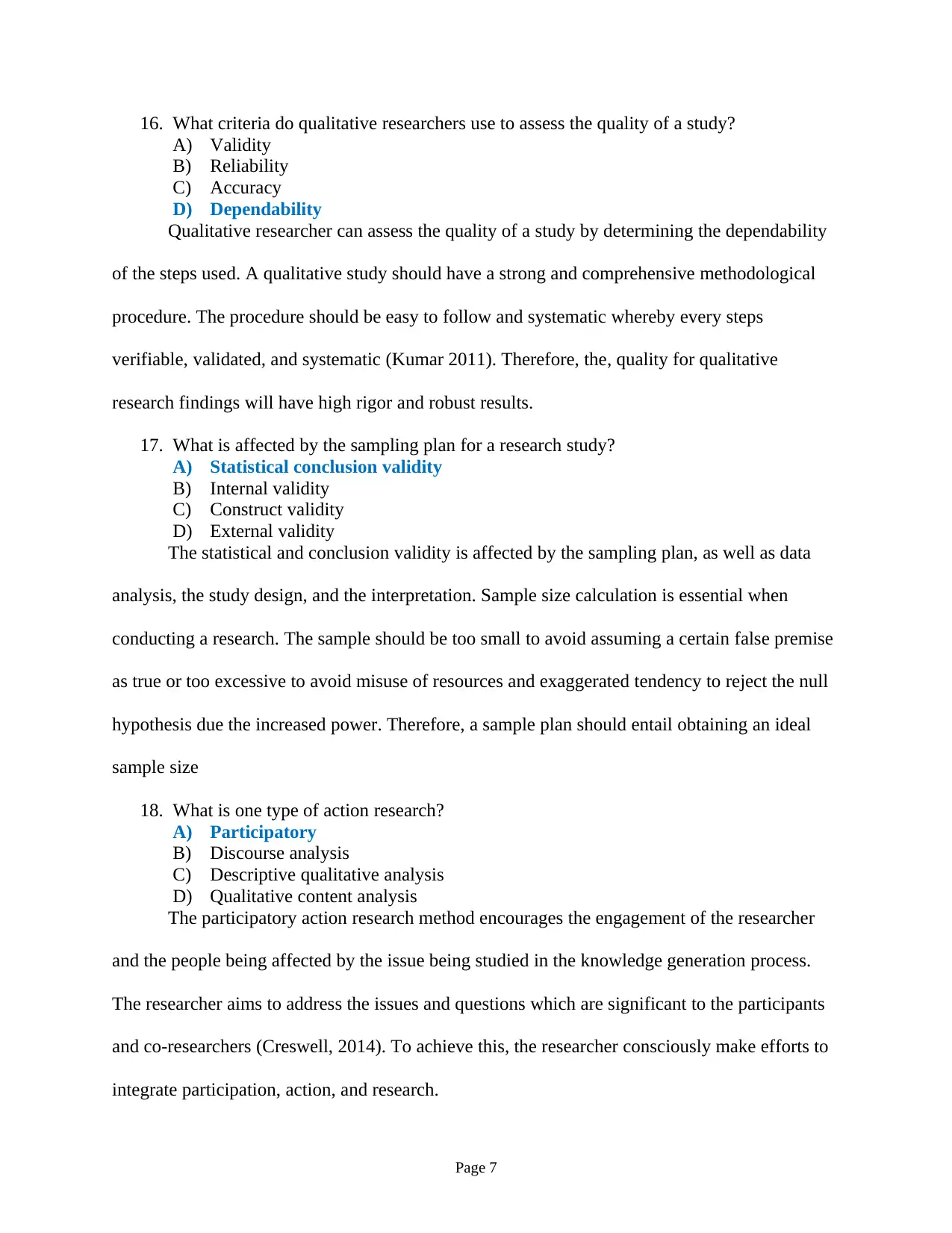
16. What criteria do qualitative researchers use to assess the quality of a study?
A) Validity
B) Reliability
C) Accuracy
D) Dependability
Qualitative researcher can assess the quality of a study by determining the dependability
of the steps used. A qualitative study should have a strong and comprehensive methodological
procedure. The procedure should be easy to follow and systematic whereby every steps
verifiable, validated, and systematic (Kumar 2011). Therefore, the, quality for qualitative
research findings will have high rigor and robust results.
17. What is affected by the sampling plan for a research study?
A) Statistical conclusion validity
B) Internal validity
C) Construct validity
D) External validity
The statistical and conclusion validity is affected by the sampling plan, as well as data
analysis, the study design, and the interpretation. Sample size calculation is essential when
conducting a research. The sample should be too small to avoid assuming a certain false premise
as true or too excessive to avoid misuse of resources and exaggerated tendency to reject the null
hypothesis due the increased power. Therefore, a sample plan should entail obtaining an ideal
sample size
18. What is one type of action research?
A) Participatory
B) Discourse analysis
C) Descriptive qualitative analysis
D) Qualitative content analysis
The participatory action research method encourages the engagement of the researcher
and the people being affected by the issue being studied in the knowledge generation process.
The researcher aims to address the issues and questions which are significant to the participants
and co-researchers (Creswell, 2014). To achieve this, the researcher consciously make efforts to
integrate participation, action, and research.
Page 7
A) Validity
B) Reliability
C) Accuracy
D) Dependability
Qualitative researcher can assess the quality of a study by determining the dependability
of the steps used. A qualitative study should have a strong and comprehensive methodological
procedure. The procedure should be easy to follow and systematic whereby every steps
verifiable, validated, and systematic (Kumar 2011). Therefore, the, quality for qualitative
research findings will have high rigor and robust results.
17. What is affected by the sampling plan for a research study?
A) Statistical conclusion validity
B) Internal validity
C) Construct validity
D) External validity
The statistical and conclusion validity is affected by the sampling plan, as well as data
analysis, the study design, and the interpretation. Sample size calculation is essential when
conducting a research. The sample should be too small to avoid assuming a certain false premise
as true or too excessive to avoid misuse of resources and exaggerated tendency to reject the null
hypothesis due the increased power. Therefore, a sample plan should entail obtaining an ideal
sample size
18. What is one type of action research?
A) Participatory
B) Discourse analysis
C) Descriptive qualitative analysis
D) Qualitative content analysis
The participatory action research method encourages the engagement of the researcher
and the people being affected by the issue being studied in the knowledge generation process.
The researcher aims to address the issues and questions which are significant to the participants
and co-researchers (Creswell, 2014). To achieve this, the researcher consciously make efforts to
integrate participation, action, and research.
Page 7
Paraphrase This Document
Need a fresh take? Get an instant paraphrase of this document with our AI Paraphraser
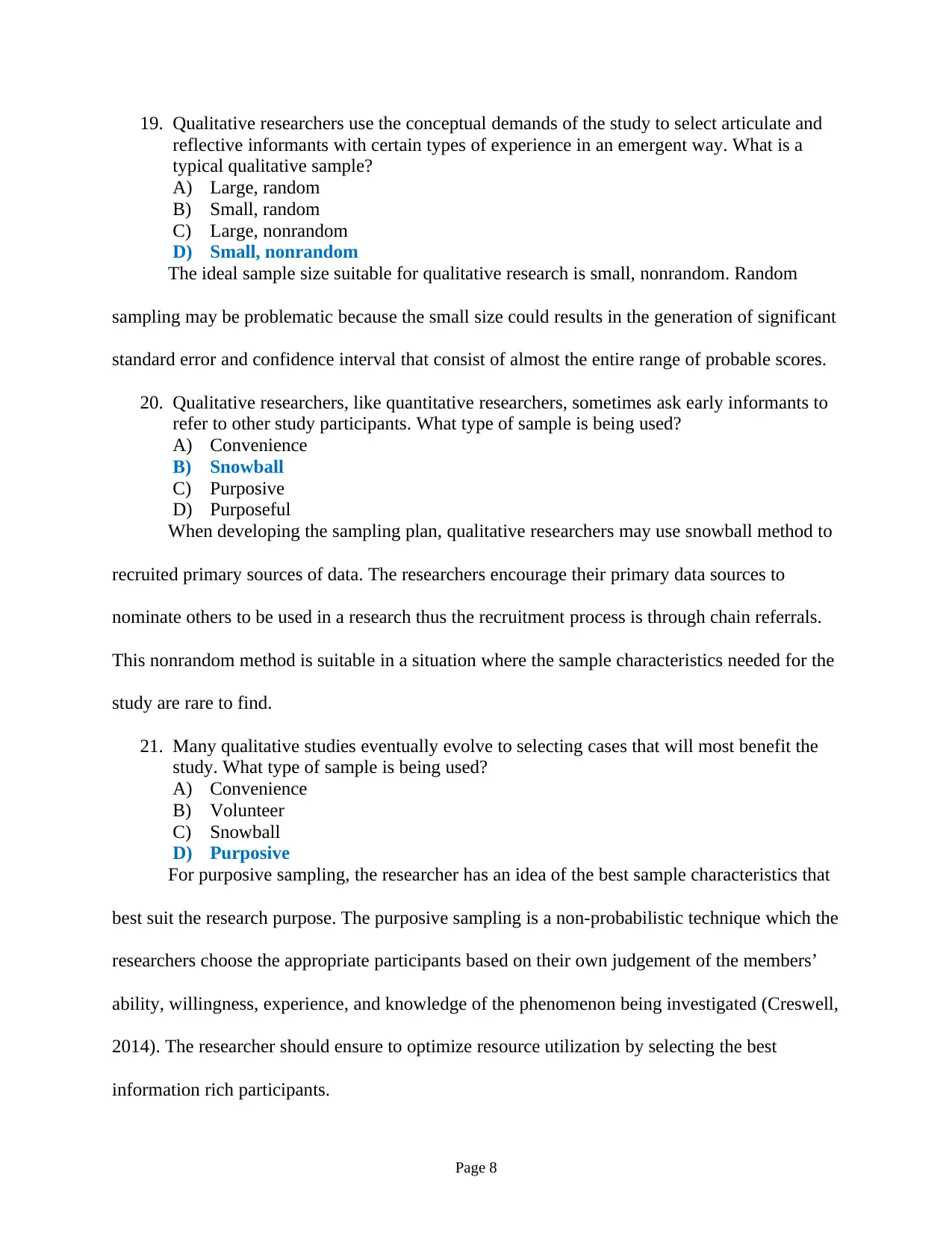
19. Qualitative researchers use the conceptual demands of the study to select articulate and
reflective informants with certain types of experience in an emergent way. What is a
typical qualitative sample?
A) Large, random
B) Small, random
C) Large, nonrandom
D) Small, nonrandom
The ideal sample size suitable for qualitative research is small, nonrandom. Random
sampling may be problematic because the small size could results in the generation of significant
standard error and confidence interval that consist of almost the entire range of probable scores.
20. Qualitative researchers, like quantitative researchers, sometimes ask early informants to
refer to other study participants. What type of sample is being used?
A) Convenience
B) Snowball
C) Purposive
D) Purposeful
When developing the sampling plan, qualitative researchers may use snowball method to
recruited primary sources of data. The researchers encourage their primary data sources to
nominate others to be used in a research thus the recruitment process is through chain referrals.
This nonrandom method is suitable in a situation where the sample characteristics needed for the
study are rare to find.
21. Many qualitative studies eventually evolve to selecting cases that will most benefit the
study. What type of sample is being used?
A) Convenience
B) Volunteer
C) Snowball
D) Purposive
For purposive sampling, the researcher has an idea of the best sample characteristics that
best suit the research purpose. The purposive sampling is a non-probabilistic technique which the
researchers choose the appropriate participants based on their own judgement of the members’
ability, willingness, experience, and knowledge of the phenomenon being investigated (Creswell,
2014). The researcher should ensure to optimize resource utilization by selecting the best
information rich participants.
Page 8
reflective informants with certain types of experience in an emergent way. What is a
typical qualitative sample?
A) Large, random
B) Small, random
C) Large, nonrandom
D) Small, nonrandom
The ideal sample size suitable for qualitative research is small, nonrandom. Random
sampling may be problematic because the small size could results in the generation of significant
standard error and confidence interval that consist of almost the entire range of probable scores.
20. Qualitative researchers, like quantitative researchers, sometimes ask early informants to
refer to other study participants. What type of sample is being used?
A) Convenience
B) Snowball
C) Purposive
D) Purposeful
When developing the sampling plan, qualitative researchers may use snowball method to
recruited primary sources of data. The researchers encourage their primary data sources to
nominate others to be used in a research thus the recruitment process is through chain referrals.
This nonrandom method is suitable in a situation where the sample characteristics needed for the
study are rare to find.
21. Many qualitative studies eventually evolve to selecting cases that will most benefit the
study. What type of sample is being used?
A) Convenience
B) Volunteer
C) Snowball
D) Purposive
For purposive sampling, the researcher has an idea of the best sample characteristics that
best suit the research purpose. The purposive sampling is a non-probabilistic technique which the
researchers choose the appropriate participants based on their own judgement of the members’
ability, willingness, experience, and knowledge of the phenomenon being investigated (Creswell,
2014). The researcher should ensure to optimize resource utilization by selecting the best
information rich participants.
Page 8
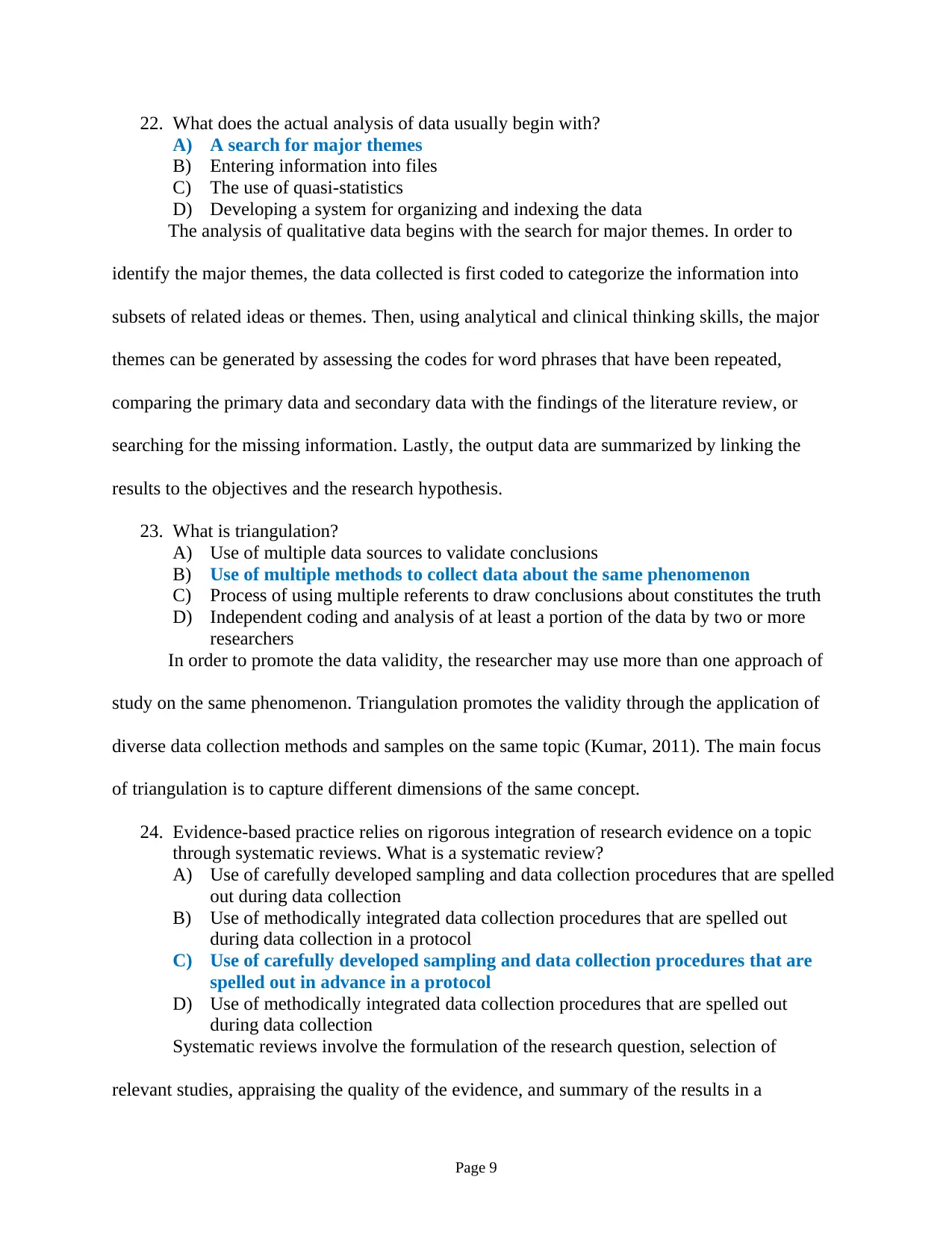
22. What does the actual analysis of data usually begin with?
A) A search for major themes
B) Entering information into files
C) The use of quasi-statistics
D) Developing a system for organizing and indexing the data
The analysis of qualitative data begins with the search for major themes. In order to
identify the major themes, the data collected is first coded to categorize the information into
subsets of related ideas or themes. Then, using analytical and clinical thinking skills, the major
themes can be generated by assessing the codes for word phrases that have been repeated,
comparing the primary data and secondary data with the findings of the literature review, or
searching for the missing information. Lastly, the output data are summarized by linking the
results to the objectives and the research hypothesis.
23. What is triangulation?
A) Use of multiple data sources to validate conclusions
B) Use of multiple methods to collect data about the same phenomenon
C) Process of using multiple referents to draw conclusions about constitutes the truth
D) Independent coding and analysis of at least a portion of the data by two or more
researchers
In order to promote the data validity, the researcher may use more than one approach of
study on the same phenomenon. Triangulation promotes the validity through the application of
diverse data collection methods and samples on the same topic (Kumar, 2011). The main focus
of triangulation is to capture different dimensions of the same concept.
24. Evidence-based practice relies on rigorous integration of research evidence on a topic
through systematic reviews. What is a systematic review?
A) Use of carefully developed sampling and data collection procedures that are spelled
out during data collection
B) Use of methodically integrated data collection procedures that are spelled out
during data collection in a protocol
C) Use of carefully developed sampling and data collection procedures that are
spelled out in advance in a protocol
D) Use of methodically integrated data collection procedures that are spelled out
during data collection
Systematic reviews involve the formulation of the research question, selection of
relevant studies, appraising the quality of the evidence, and summary of the results in a
Page 9
A) A search for major themes
B) Entering information into files
C) The use of quasi-statistics
D) Developing a system for organizing and indexing the data
The analysis of qualitative data begins with the search for major themes. In order to
identify the major themes, the data collected is first coded to categorize the information into
subsets of related ideas or themes. Then, using analytical and clinical thinking skills, the major
themes can be generated by assessing the codes for word phrases that have been repeated,
comparing the primary data and secondary data with the findings of the literature review, or
searching for the missing information. Lastly, the output data are summarized by linking the
results to the objectives and the research hypothesis.
23. What is triangulation?
A) Use of multiple data sources to validate conclusions
B) Use of multiple methods to collect data about the same phenomenon
C) Process of using multiple referents to draw conclusions about constitutes the truth
D) Independent coding and analysis of at least a portion of the data by two or more
researchers
In order to promote the data validity, the researcher may use more than one approach of
study on the same phenomenon. Triangulation promotes the validity through the application of
diverse data collection methods and samples on the same topic (Kumar, 2011). The main focus
of triangulation is to capture different dimensions of the same concept.
24. Evidence-based practice relies on rigorous integration of research evidence on a topic
through systematic reviews. What is a systematic review?
A) Use of carefully developed sampling and data collection procedures that are spelled
out during data collection
B) Use of methodically integrated data collection procedures that are spelled out
during data collection in a protocol
C) Use of carefully developed sampling and data collection procedures that are
spelled out in advance in a protocol
D) Use of methodically integrated data collection procedures that are spelled out
during data collection
Systematic reviews involve the formulation of the research question, selection of
relevant studies, appraising the quality of the evidence, and summary of the results in a
Page 9
⊘ This is a preview!⊘
Do you want full access?
Subscribe today to unlock all pages.

Trusted by 1+ million students worldwide
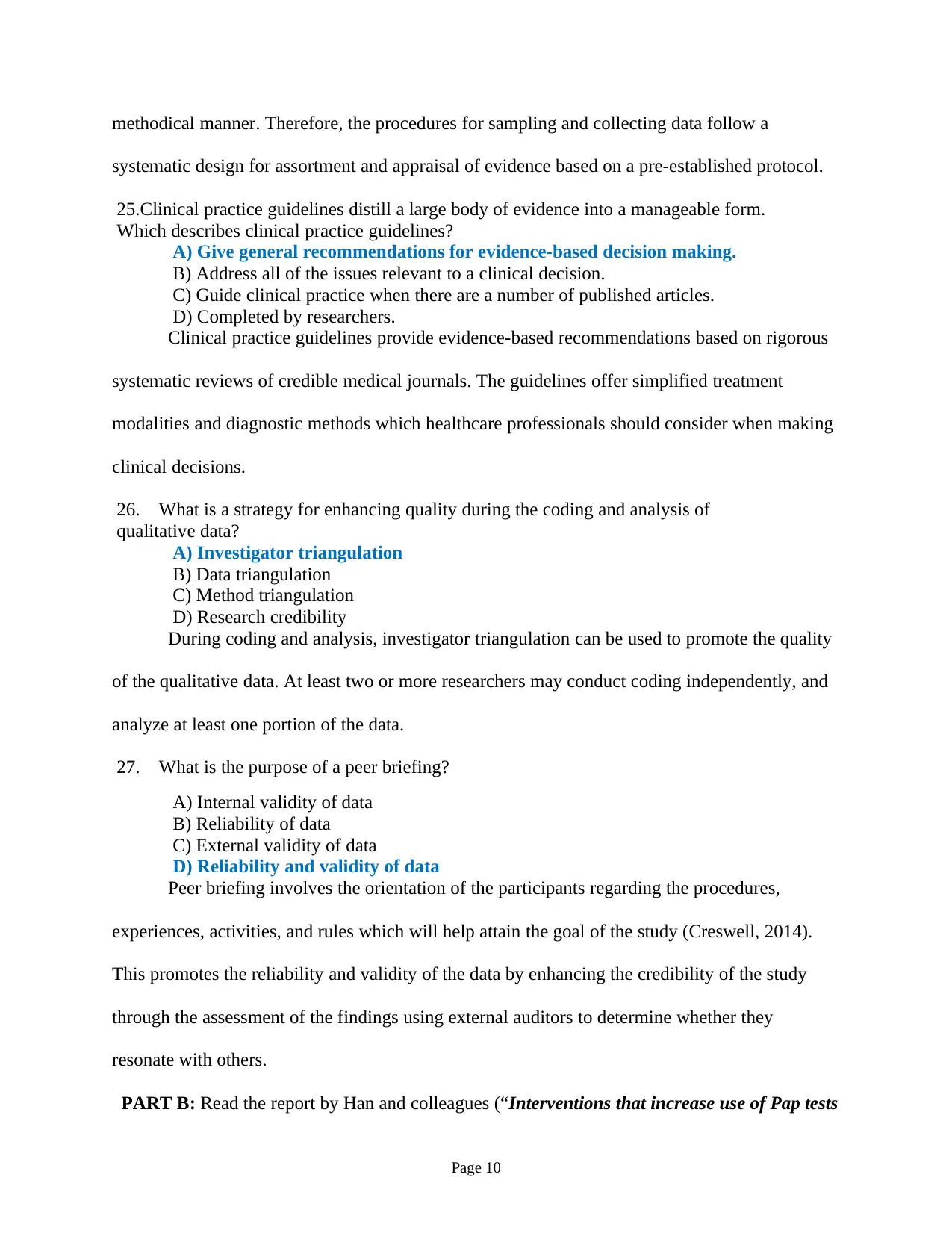
methodical manner. Therefore, the procedures for sampling and collecting data follow a
systematic design for assortment and appraisal of evidence based on a pre-established protocol.
25.Clinical practice guidelines distill a large body of evidence into a manageable form.
Which describes clinical practice guidelines?
A) Give general recommendations for evidence-based decision making.
B) Address all of the issues relevant to a clinical decision.
C) Guide clinical practice when there are a number of published articles.
D) Completed by researchers.
Clinical practice guidelines provide evidence-based recommendations based on rigorous
systematic reviews of credible medical journals. The guidelines offer simplified treatment
modalities and diagnostic methods which healthcare professionals should consider when making
clinical decisions.
26. What is a strategy for enhancing quality during the coding and analysis of
qualitative data?
A) Investigator triangulation
B) Data triangulation
C) Method triangulation
D) Research credibility
During coding and analysis, investigator triangulation can be used to promote the quality
of the qualitative data. At least two or more researchers may conduct coding independently, and
analyze at least one portion of the data.
27. What is the purpose of a peer briefing?
A) Internal validity of data
B) Reliability of data
C) External validity of data
D) Reliability and validity of data
Peer briefing involves the orientation of the participants regarding the procedures,
experiences, activities, and rules which will help attain the goal of the study (Creswell, 2014).
This promotes the reliability and validity of the data by enhancing the credibility of the study
through the assessment of the findings using external auditors to determine whether they
resonate with others.
PART B: Read the report by Han and colleagues (“Interventions that increase use of Pap tests
Page 10
systematic design for assortment and appraisal of evidence based on a pre-established protocol.
25.Clinical practice guidelines distill a large body of evidence into a manageable form.
Which describes clinical practice guidelines?
A) Give general recommendations for evidence-based decision making.
B) Address all of the issues relevant to a clinical decision.
C) Guide clinical practice when there are a number of published articles.
D) Completed by researchers.
Clinical practice guidelines provide evidence-based recommendations based on rigorous
systematic reviews of credible medical journals. The guidelines offer simplified treatment
modalities and diagnostic methods which healthcare professionals should consider when making
clinical decisions.
26. What is a strategy for enhancing quality during the coding and analysis of
qualitative data?
A) Investigator triangulation
B) Data triangulation
C) Method triangulation
D) Research credibility
During coding and analysis, investigator triangulation can be used to promote the quality
of the qualitative data. At least two or more researchers may conduct coding independently, and
analyze at least one portion of the data.
27. What is the purpose of a peer briefing?
A) Internal validity of data
B) Reliability of data
C) External validity of data
D) Reliability and validity of data
Peer briefing involves the orientation of the participants regarding the procedures,
experiences, activities, and rules which will help attain the goal of the study (Creswell, 2014).
This promotes the reliability and validity of the data by enhancing the credibility of the study
through the assessment of the findings using external auditors to determine whether they
resonate with others.
PART B: Read the report by Han and colleagues (“Interventions that increase use of Pap tests
Page 10
Paraphrase This Document
Need a fresh take? Get an instant paraphrase of this document with our AI Paraphraser
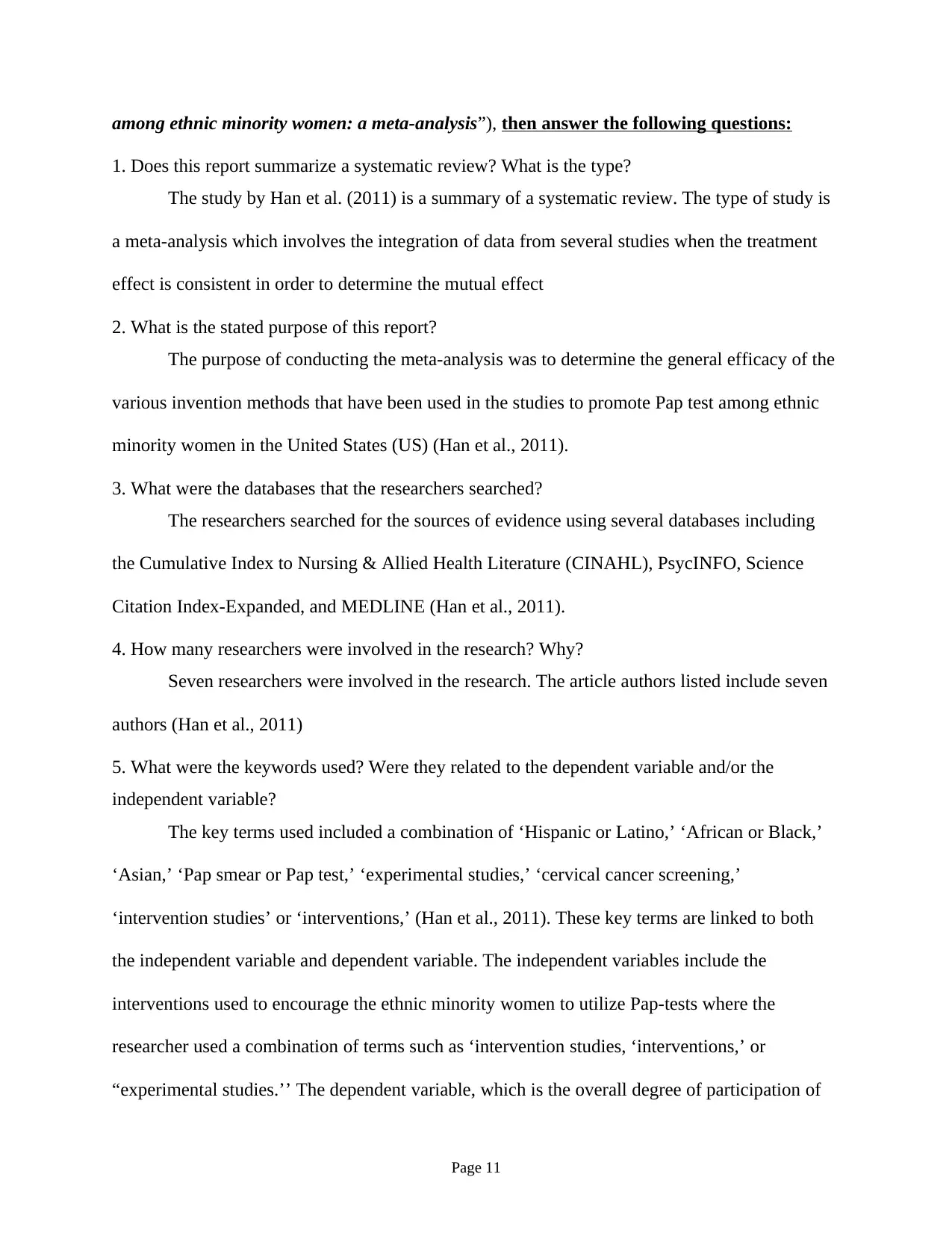
among ethnic minority women: a meta-analysis”), then answer the following questions:
1. Does this report summarize a systematic review? What is the type?
The study by Han et al. (2011) is a summary of a systematic review. The type of study is
a meta-analysis which involves the integration of data from several studies when the treatment
effect is consistent in order to determine the mutual effect
2. What is the stated purpose of this report?
The purpose of conducting the meta-analysis was to determine the general efficacy of the
various invention methods that have been used in the studies to promote Pap test among ethnic
minority women in the United States (US) (Han et al., 2011).
3. What were the databases that the researchers searched?
The researchers searched for the sources of evidence using several databases including
the Cumulative Index to Nursing & Allied Health Literature (CINAHL), PsycINFO, Science
Citation Index-Expanded, and MEDLINE (Han et al., 2011).
4. How many researchers were involved in the research? Why?
Seven researchers were involved in the research. The article authors listed include seven
authors (Han et al., 2011)
5. What were the keywords used? Were they related to the dependent variable and/or the
independent variable?
The key terms used included a combination of ‘Hispanic or Latino,’ ‘African or Black,’
‘Asian,’ ‘Pap smear or Pap test,’ ‘experimental studies,’ ‘cervical cancer screening,’
‘intervention studies’ or ‘interventions,’ (Han et al., 2011). These key terms are linked to both
the independent variable and dependent variable. The independent variables include the
interventions used to encourage the ethnic minority women to utilize Pap-tests where the
researcher used a combination of terms such as ‘intervention studies, ‘interventions,’ or
“experimental studies.’’ The dependent variable, which is the overall degree of participation of
Page 11
1. Does this report summarize a systematic review? What is the type?
The study by Han et al. (2011) is a summary of a systematic review. The type of study is
a meta-analysis which involves the integration of data from several studies when the treatment
effect is consistent in order to determine the mutual effect
2. What is the stated purpose of this report?
The purpose of conducting the meta-analysis was to determine the general efficacy of the
various invention methods that have been used in the studies to promote Pap test among ethnic
minority women in the United States (US) (Han et al., 2011).
3. What were the databases that the researchers searched?
The researchers searched for the sources of evidence using several databases including
the Cumulative Index to Nursing & Allied Health Literature (CINAHL), PsycINFO, Science
Citation Index-Expanded, and MEDLINE (Han et al., 2011).
4. How many researchers were involved in the research? Why?
Seven researchers were involved in the research. The article authors listed include seven
authors (Han et al., 2011)
5. What were the keywords used? Were they related to the dependent variable and/or the
independent variable?
The key terms used included a combination of ‘Hispanic or Latino,’ ‘African or Black,’
‘Asian,’ ‘Pap smear or Pap test,’ ‘experimental studies,’ ‘cervical cancer screening,’
‘intervention studies’ or ‘interventions,’ (Han et al., 2011). These key terms are linked to both
the independent variable and dependent variable. The independent variables include the
interventions used to encourage the ethnic minority women to utilize Pap-tests where the
researcher used a combination of terms such as ‘intervention studies, ‘interventions,’ or
“experimental studies.’’ The dependent variable, which is the overall degree of participation of
Page 11
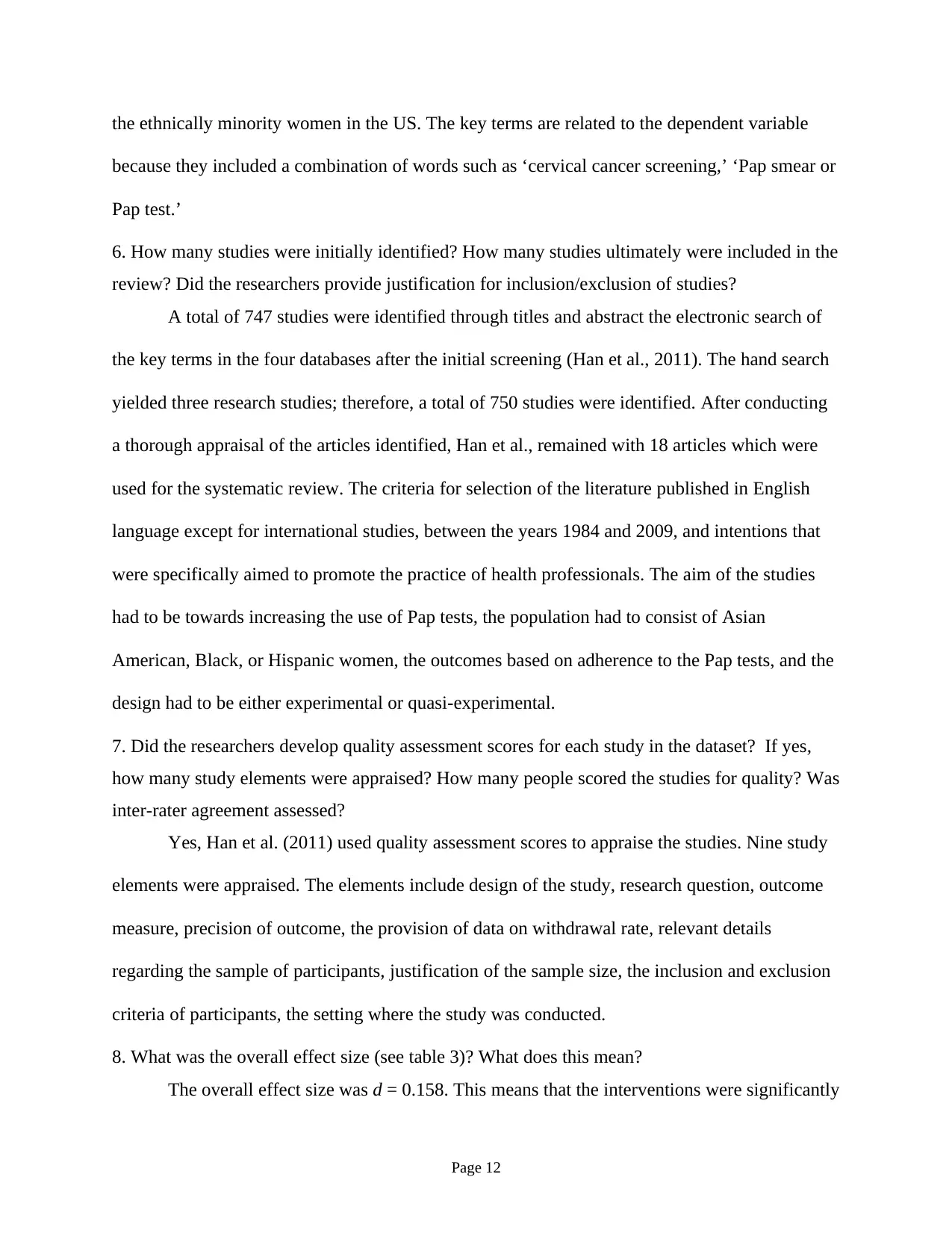
the ethnically minority women in the US. The key terms are related to the dependent variable
because they included a combination of words such as ‘cervical cancer screening,’ ‘Pap smear or
Pap test.’
6. How many studies were initially identified? How many studies ultimately were included in the
review? Did the researchers provide justification for inclusion/exclusion of studies?
A total of 747 studies were identified through titles and abstract the electronic search of
the key terms in the four databases after the initial screening (Han et al., 2011). The hand search
yielded three research studies; therefore, a total of 750 studies were identified. After conducting
a thorough appraisal of the articles identified, Han et al., remained with 18 articles which were
used for the systematic review. The criteria for selection of the literature published in English
language except for international studies, between the years 1984 and 2009, and intentions that
were specifically aimed to promote the practice of health professionals. The aim of the studies
had to be towards increasing the use of Pap tests, the population had to consist of Asian
American, Black, or Hispanic women, the outcomes based on adherence to the Pap tests, and the
design had to be either experimental or quasi-experimental.
7. Did the researchers develop quality assessment scores for each study in the dataset? If yes,
how many study elements were appraised? How many people scored the studies for quality? Was
inter-rater agreement assessed?
Yes, Han et al. (2011) used quality assessment scores to appraise the studies. Nine study
elements were appraised. The elements include design of the study, research question, outcome
measure, precision of outcome, the provision of data on withdrawal rate, relevant details
regarding the sample of participants, justification of the sample size, the inclusion and exclusion
criteria of participants, the setting where the study was conducted.
8. What was the overall effect size (see table 3)? What does this mean?
The overall effect size was d = 0.158. This means that the interventions were significantly
Page 12
because they included a combination of words such as ‘cervical cancer screening,’ ‘Pap smear or
Pap test.’
6. How many studies were initially identified? How many studies ultimately were included in the
review? Did the researchers provide justification for inclusion/exclusion of studies?
A total of 747 studies were identified through titles and abstract the electronic search of
the key terms in the four databases after the initial screening (Han et al., 2011). The hand search
yielded three research studies; therefore, a total of 750 studies were identified. After conducting
a thorough appraisal of the articles identified, Han et al., remained with 18 articles which were
used for the systematic review. The criteria for selection of the literature published in English
language except for international studies, between the years 1984 and 2009, and intentions that
were specifically aimed to promote the practice of health professionals. The aim of the studies
had to be towards increasing the use of Pap tests, the population had to consist of Asian
American, Black, or Hispanic women, the outcomes based on adherence to the Pap tests, and the
design had to be either experimental or quasi-experimental.
7. Did the researchers develop quality assessment scores for each study in the dataset? If yes,
how many study elements were appraised? How many people scored the studies for quality? Was
inter-rater agreement assessed?
Yes, Han et al. (2011) used quality assessment scores to appraise the studies. Nine study
elements were appraised. The elements include design of the study, research question, outcome
measure, precision of outcome, the provision of data on withdrawal rate, relevant details
regarding the sample of participants, justification of the sample size, the inclusion and exclusion
criteria of participants, the setting where the study was conducted.
8. What was the overall effect size (see table 3)? What does this mean?
The overall effect size was d = 0.158. This means that the interventions were significantly
Page 12
⊘ This is a preview!⊘
Do you want full access?
Subscribe today to unlock all pages.

Trusted by 1+ million students worldwide
1 out of 15
Related Documents
Your All-in-One AI-Powered Toolkit for Academic Success.
+13062052269
info@desklib.com
Available 24*7 on WhatsApp / Email
![[object Object]](/_next/static/media/star-bottom.7253800d.svg)
Unlock your academic potential
Copyright © 2020–2025 A2Z Services. All Rights Reserved. Developed and managed by ZUCOL.





